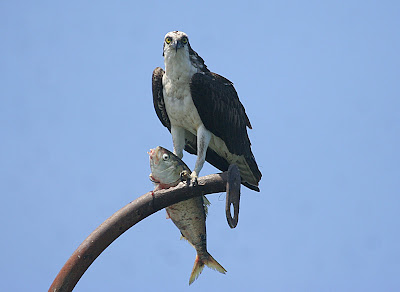afternoon and have a look around, perhaps it was my nephew's
report of a raccoon sleeping under a Osprey nest
 in Norwalk?
in Norwalk?Neither birds were sitting on the nest when I arrived, they were perched on a nearby house, this was not a good sign, as one bird almost always stays with the nest and eggs or young chicks.
A few days ago Ken found a raccoon sleeping just below the nest, which is on a group of pilings around Rowayton, CT. I'll look into it further.
Off to Cockenoe Island four miles to the east to check on the tern colony, first I stop in the bay and check out the shoreline for shore birds, it's high tide and every twenty or so feet, I see horseshoe crabs, paired up and digging into the sand to lay their eggs.
I think to myself, that's pretty cool, sort of like the Nature show I've seen on PBS, The Tale of Two Species, or something like that, it is a fantastic one hour documentary about the interconnecting lives of the horseshoe crab and the Red Knot, oh well, we have the crabs, but the knot could be tough.
I venture over to the tern sandbar, put the bow on the shore and start counting terns, the numbers are growing since this past weekend, I've got at least eighty three Least Terns, with about forty sitting on nest, over a hundred Common Terns, I didn't get a nest count since I could not see the other end of the bar.
There are also a number of shorebirds hanging around the high tide line, a few hundred Semipalmated sandpipers, sixty Ruddy Turnstone, thirty Dunlin, fifteen Black-bellied Plover, eight Semipalmated Plover, eight oystercatchers and a pair of Spotted Sandpipers,
Nice numbers for this tiny bar, barely two hundred feet long and maybe fifty feet wide at it's widest.
A flock of shorbs fly by the other side of the sandbar, alright! These guys are different, they land about sixty feet away, it's a good mix but the first oddities I pick out are a bunch of Red Knot,
Twenty three in total, also with them are fourteen Short-Billed Dowitchers, some Ruddy's and Semi/sands.
I'm excited to see these Knots, and the camera is firing fast.
It wasn't until I came home and down loaded the pics, that I noticed the flagged and banded
Red Knot.
I have sent this birds information out, but if anyone wants to further use it, that's OK with me.
The flag number is A9S in red, also with a red band on opposite leg.

Horseshoe crabs, she's almost completely buried
She is completely buried below the sand
It's not Delaware Bay, but The Norwalk Island do lend a helping hand.
Dunlin and Semipalmated Sandpipers?
Click on any of these photos to get a closer look.
The white headed, black chested, brown backed birds are Ruddy Turnstones,
the other drabber birds are Red Knot.

A few Short-billed Dowitchers, Semipalmated Sandpipers to the right
From the information that I have picked up, and I hope I'm right
This bird should have been banded in Chile.
These birds all appear to be nice and plump, a good thing,
they still have a long way to go on their migration,
north about as far as you can go, just before you run into ice and snow.
NEW NOTE! Data base tells me this is orange, not red
The numbers only match up to orange,
The numbers only match up to orange,
THIS BIRD IS NOT FROM CHILE, BUT ARGENTINA
in this case a sand lance, (sand eel)
The catch would be offered to a number of birds, then when
he could find a bird to finally except it, he would pull back,
fly away and start all over again.
This is a pair of Common Terns mating.
More nest will be coming.
with an Menhaden (bunker) that eventually he will share with
the female and the kids.











+copy.jpg)



Larry,
ReplyDeleteThat is one very productive sand spit. Those tern nests must be very close together. Let's hope that the raccoon(s) don't make it out there.
I wish I took a photo of that racoon when I was there. May never see that again. My mistake
ReplyDelete